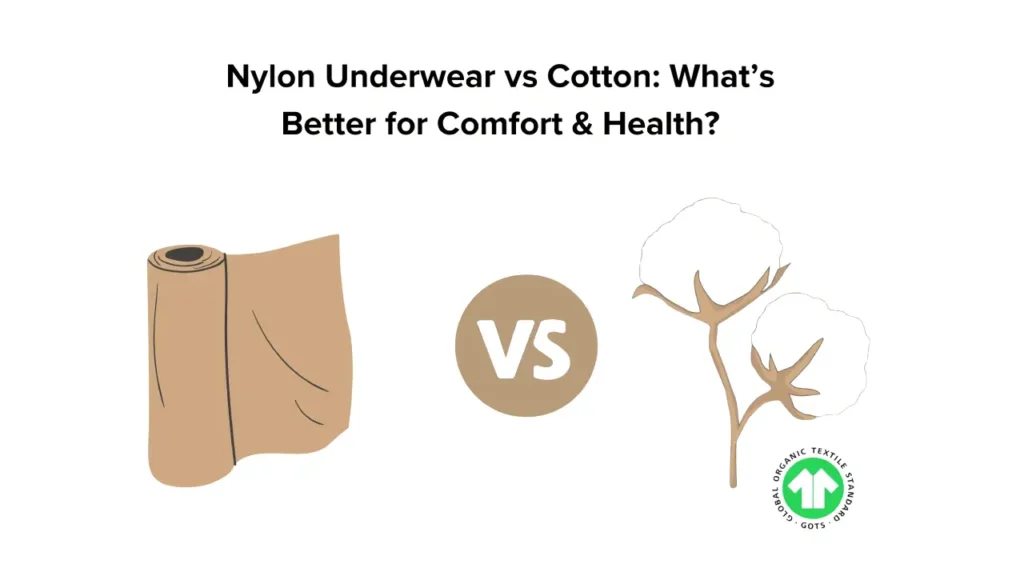When it comes to underwear, the choice of fabric significantly impacts comfort and functionality. Two popular options, nylon and cotton, offer distinct characteristics that cater to different preferences and needs. Understanding the differences between these materials is key to selecting the underwear that best suits your lifestyle and ensures all-day comfort.
This blog delves into the contrasting properties of nylon and cotton underwear. We’ll explore their breathability, moisture-wicking capabilities, durability, and overall feel against the skin, providing you with the knowledge to make an informed decision for your next underwear purchase.
What Is Nylon Underwear

Nylon underwear is crafted from a synthetic fabric known for its smooth, silky texture and exceptional durability. Unlike natural fibers, nylon is lightweight, strong, and resistant to wear and tear, even after numerous washes. Often blended with spandex or elastane, nylon underwear offers a stretchy, form-fitting feel that moves with the body.
A key characteristic of nylon is its moisture-wicking ability, drawing sweat away from the skin and drying quickly. This makes it a popular choice for activewear and those seeking a dry and comfortable feel throughout the day. Additionally, nylon’s smooth nature helps prevent visible panty lines, making it ideal for wearing under fitted clothing.
What is Cotton Underwear

Cotton underwear is made from natural fibers derived from the cotton plant, prized for its exceptional softness and breathability. This makes it a comfortable and gentle choice for everyday wear, especially for individuals with sensitive skin or allergies, as it is naturally hypoallergenic and less likely to cause irritation.
One of the key benefits of cotton is its excellent absorbency, effectively wicking away moisture from the skin to help keep you feeling dry and fresh throughout the day. However, it’s worth noting that while cotton absorbs moisture well, it can also retain it, potentially making it less ideal for high-intensity workouts where quick-drying fabrics are preferred.
Nylon Underwear vs Cotton

Choosing between nylon and cotton for underwear often comes down to prioritizing different comfort and performance characteristics. Both fabrics are widely used in the undergarment industry, but they possess distinct properties that make them suitable for various needs and preferences.
Understanding these differences across key aspects like breathability, moisture management, and durability can help you make an informed decision for your everyday wear or specific activities. Let’s delve into a detailed comparison of nylon and cotton underwear.
Comfort
Cotton underwear is celebrated for its natural softness and gentle touch against the skin, making it an ideal choice for everyday wear. The inherent breathability of cotton fibers minimizes irritation, a significant benefit for individuals with sensitive skin or allergies. This natural comfort allows for extended wear without the feeling of being constricted or uncomfortable, contributing to overall well-being throughout the day.
Conversely, nylon underwear, while often possessing a smooth and silky texture that can feel pleasant initially, may not offer the same level of sustained comfort, particularly in warmer climates or during prolonged periods of wear. Its synthetic composition can sometimes trap heat and moisture, leading to a less breathable experience compared to cotton. However, advancements in fabric technology have led to the development of more breathable nylon blends that aim to mitigate these comfort concerns.
Moisture-Wicking
Nylon underwear typically excels in its ability to wick away moisture from the skin, a crucial feature for maintaining dryness and comfort during physical activity. The synthetic fibers are specifically engineered to draw sweat to the outer layer of the fabric, where it can evaporate more readily. This efficient moisture management helps to prevent that damp, clinging sensation that can occur with less effective fabrics.
In contrast, cotton, while highly absorbent, tends to retain moisture rather than effectively wicking it away. This means that while it can initially absorb sweat, it can remain damp against the skin, potentially leading to discomfort, chafing, and an increased risk of bacterial growth, especially during intense workouts or in humid conditions. Consequently, cotton underwear is generally less preferred for activities where moisture management is paramount.
Breathability
The natural fiber structure of cotton allows for excellent air circulation, promoting breathability and helping to regulate body temperature. This inherent breathability facilitates the evaporation of moisture, contributing to a cooler and drier feel, which is particularly advantageous in warmer weather or during less strenuous activities. The open weave of cotton allows the skin to breathe freely, reducing the likelihood of heat and moisture buildup.
Nylon, with its typically tighter weave and synthetic composition, generally offers less breathability than cotton. The denser structure can restrict airflow, potentially trapping heat and moisture against the skin. While some nylon blends incorporate features like mesh panels or specific weaving techniques to enhance ventilation, they often do not match the natural breathability afforded by cotton’s fiber structure.
Durability
Nylon is generally recognized for its superior durability compared to cotton. The synthetic fibers are inherently strong and resistant to abrasion, stretching, and tearing, allowing nylon underwear to withstand frequent washing and wear without losing its shape or integrity. This resilience often translates to a longer lifespan for nylon undergarments, making them a potentially more cost-effective option in the long run.
Cotton, while still a reasonably durable natural fiber, is more susceptible to wear and tear over time. Repeated washing, especially in hot water and with harsh detergents, can cause cotton fibers to weaken, leading to stretching, fading of color, and the development of pilling. While high-quality cotton can last a decent amount of time, it typically does not possess the same level of inherent strength and resilience as nylon.
Appearance
Nylon underwear often presents a sleek, smooth, and sometimes slightly shiny appearance, contributing to a polished and modern aesthetic. The synthetic fibers readily accept dyes, allowing for vibrant and long-lasting colors. Furthermore, nylon’s resistance to wrinkling helps maintain a smooth and presentable look even after washing and packing. Its smooth texture also often contributes to a seamless profile under outer clothing.
Cotton underwear typically has a more matte and natural appearance, which many find appealing for its understated simplicity. While cotton can also be dyed in a wide range of colors, it may be more prone to fading over time compared to nylon. Additionally, cotton fabrics tend to wrinkle more easily after washing and may require ironing to achieve a smooth look.
Sustainability
The production of conventional cotton can have significant environmental drawbacks, including high water consumption, the extensive use of pesticides and fertilizers, and substantial land requirements. These practices can contribute to soil degradation, water pollution, and biodiversity loss. Choosing organic cotton can mitigate some of these issues, as it is grown without synthetic pesticides and fertilizers, but it often comes at a higher cost.
Nylon, derived from petroleum, a non-renewable resource, also has environmental implications associated with its production. The manufacturing process is energy-intensive and can release greenhouse gases. However, advancements in textile technology are leading to the development of recycled nylon options, which utilize existing nylon materials to reduce the demand for new petroleum and minimize waste. The overall sustainability of either fabric depends on various factors, including production methods and end-of-life management.
Cost
Cotton underwear is generally more budget-friendly compared to nylon underwear. The widespread cultivation of cotton makes it a readily available and relatively inexpensive raw material. This cost-effectiveness is often reflected in the price of cotton undergarments, making them an accessible option for everyday wear.
Nylon, being a synthetic fiber that requires a more complex chemical manufacturing process, typically incurs higher production costs. These costs are often passed on to the consumer, resulting in a higher price point for nylon underwear. However, the perceived benefits of durability, moisture-wicking, and a sleek appearance may justify the higher cost for some individuals.
Here is the table showing you the differences between nylon underwear and cotton underwear in the following:
| Feature | Cotton Underwear | Nylon Underwear |
| Comfort | Soft, gentle on skin, breathable for many. | Smooth, silky feel; can be less breathable for some. |
| Moisture-Wicking | Absorbent, but retains moisture. | Excellent at wicking away moisture, quick-drying. |
| Breathability | High breathability, allows for air circulation. | Lower breathability compared to cotton. |
| Durability | Moderate, prone to stretching, fading, pilling. | High durability, resistant to wear and tear. |
| Appearance | Matte, natural look; may wrinkle. | Sleek, smooth, may have a slight sheen; resists wrinkles. |
| Sustainability | Conventional farming has high environmental impact; organic cotton is better but pricier. | Made from non-renewable petroleum; recycled options emerging. |
| Cost | Generally more affordable. | Generally more expensive. |
How to Choose Nylon Underwear and Cotton Underwear
Selecting between nylon and cotton underwear hinges on understanding your primary needs and preferences. For everyday comfort and breathability, especially in warmer climates or for those with sensitive skin, cotton is often the preferred choice. Its natural fibers are gentle and absorbent.
However, for activities where moisture-wicking is crucial, such as workouts or in humid conditions, nylon’s ability to draw sweat away from the skin and dry quickly makes it a more suitable option. Consider the level of support and the desired aesthetic as well, as nylon often offers a smoother look under clothing.
When making your choice, consider these points:
- Intended Use: Is it for daily wear, exercise, or special occasions?
- Climate: Are you in a hot, humid environment where breathability and moisture-wicking are key?
- Skin Sensitivity: Do you have sensitive skin that reacts better to natural fibers like cotton?
- Desired Feel: Do you prefer the soft, natural feel of cotton or the smooth, silky feel of nylon?
- Outerwear: Will you be wearing tight-fitting clothes where a seamless look is important (nylon often excels here)?
- Durability Expectations: Are you looking for underwear that will withstand frequent washing and wear (nylon tends to be more durable)?
- Budget: Cotton is generally more affordable, while nylon can be pricier.
Conclusion
The choice between nylon and cotton underwear hinges on prioritizing different qualities. Nylon offers superior moisture-wicking and durability, often preferred for active wear and a smooth feel. Cotton, on the other hand, excels in breathability and softness, making it a classic choice for everyday comfort and sensitive skin.
Understanding these key differences allows consumers to select underwear that best suits their specific needs and preferences. Whether it’s the performance of nylon or the natural comfort of cotton, both fabrics hold significant value in the undergarment market.
For businesses looking to cater to a diverse customer base, Friendtex offers a wholesale range of underwear likely encompassing both nylon and cotton options. Partnering with Friendtex can provide access to quality undergarments that meet varied consumer demands.

